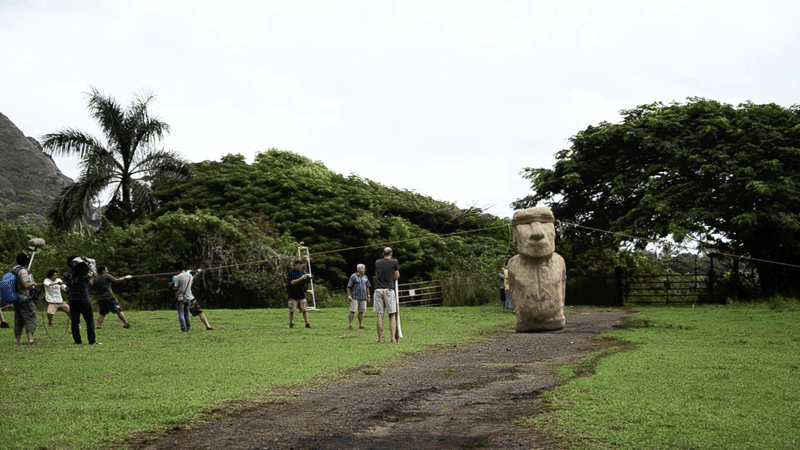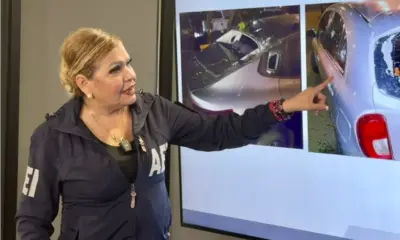Science
Easter Island’s Moai Statues Could Have ‘Walked’ with Physics

A recent study reveals that the monumental moai statues of Easter Island may have been moved using a technique resembling “walking,” with as few as 15 people, long ropes, and an understanding of pendulum dynamics. This research, published in the November 2025 issue of the Journal of Archaeological Science, challenges long-held beliefs about how the Indigenous people of Easter Island, known as Rapa Nui, transported these massive statues, which can weigh several tons.
For years, scholars have debated the logistics behind moving the moai, which typically range from 3.7 feet (1.1 meters) to 32.6 feet (9.8 meters) tall. The new findings suggest that the design of the statues themselves may have aided in their transport. Researchers observed that prematurely discarded moai lacked certain details and were crafted with a low center of mass and a forward lean, facilitating movement.
In their investigation, a team led by Carl Lipo, a professor of anthropology at Binghamton University, virtually recreated the moai. They discovered that using just three ropes and between five and 60 people, the statues could take “steps” averaging 35 inches (89 centimeters) long across the Rapa Nui landscape. This evidence contradicts the traditional view that moving the moai required a large workforce and significant resources.
The research team conducted a televised experiment in 2012, where 18 individuals successfully “walked” a scaled replica of a 4.8-ton (4.4 metric ton) moai over a distance of 328 feet (100 meters) in just 40 minutes. According to Lipo, “What we found is the fact that statues were moved with very small numbers of people in an amazingly ingenious way.” He emphasizes the simplicity and efficiency of the method, suggesting that the mechanics of the moai’s design were crucial to this process.
Understanding Moai Movement
The Rapa Nui community, which settled the island around 1,000 years ago, currently coexists with at least 962 moai, located an average of 6.2 miles (10 kilometers) from their quarry at Rano Raraku. The team examined “road moai,” statues aligned with ancient pathways, and found that these statues were engineered with a distinctive forward lean of 6 to 15 degrees. This design shifted their center of mass, creating a situation where the statues would topple if left standing alone.
The research also highlighted the importance of the moai’s D-shaped base, which acted as a pivot point during movement. The absence of eye sockets in these road moai, as opposed to their fully completed counterparts, indicates that the detailed finishing work occurred only after the statues reached their final destinations.
To further quantify their findings, the researchers modeled the physics involved in moving the moai. They calculated that a group of approximately 15 to 60 people would be required to initiate movement, while maintaining the momentum could be achieved with just 5 to 25 individuals. This mode of transport was deemed “remarkably efficient,” as tugging on the ropes induced a rocking motion, enabling the statues to step forward.
The researchers estimated that the moai could achieve an average travel speed of 1,000 feet (310 meters) per hour, with larger statues benefiting from longer strides. For a journey of 6.2 miles (10 kilometers), an average-size moai would need to take approximately 11,000 steps.
Reactions and Implications
The study has garnered attention for its innovative approach to understanding the movement of these iconic statues. Sue Hamilton, an archaeologist and professor of prehistory at University College London, described the research as “ingenious and worthwhile” but noted that it leaves room for multiple interpretations. Hamilton points out that the road moai might have been constructed with different methods depending on their ceremonial roles or the expertise of the builders.
While this research proposes a plausible method for the movement of the moai, Hamilton cautioned that it does not definitively prove that the statues were indeed transported in this manner. Critics of the “walking moai” hypothesis have yet to provide compelling alternatives that account for the existing evidence, according to Lipo and co-author Terry Hunt, a professor of anthropology at the University of Arizona.
This latest insight into the engineering and physics behind the moai offers a fascinating glimpse into the capabilities of the Rapa Nui people, highlighting their resourcefulness and understanding of mechanics in a time long before modern technology.
-

 Business5 days ago
Business5 days agoUK to Finalize Stablecoin Regulations by 2026, Boosting Crypto Sector
-

 Business5 days ago
Business5 days agoU.S. and U.K. Target Cybercriminal Networks, Seize $15 Billion
-

 Lifestyle5 days ago
Lifestyle5 days agoKISS OF LIFE’s Natty Dazzles in Micro-Shorts at Seoul Event
-

 World4 days ago
World4 days agoMilitary Artillery Plan Sparks Safety Concerns Along California Highway
-

 World5 days ago
World5 days agoTrump Signals Reluctance to Sell Tomahawk Missiles to Ukraine
-

 Business5 days ago
Business5 days agoCalifornia to Eliminate All Plastic Bags from Stores by 2026
-

 Sports5 days ago
Sports5 days agoDomenico Doran’s Stellar Performance Leads Bishop Amat to Victory
-

 Entertainment5 days ago
Entertainment5 days agoLouisiana Senate Raises Concerns Over Medicaid Cuts Amid New Bill
-

 Entertainment5 days ago
Entertainment5 days agoUtah Communities Rally as Government Shutdown Strains Resources
-

 Sports5 days ago
Sports5 days agoTrade Low, Trade High: Key NHL Players to Consider Now
-

 Science2 days ago
Science2 days agoAncient Dinosaur Discovery in Argentina Reveals Evolutionary Insights
-

 Health2 days ago
Health2 days agoUncovering the Hidden Link Between Knee Pain and Hip Issues









